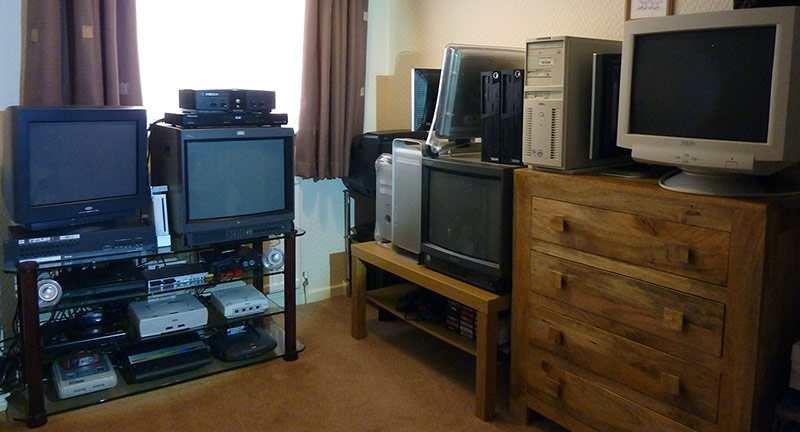
Retro Gaming vs Modern Televisions
Time passes...
It's been two years since the last update to this blog, and once again, things have changed quite a bit in that time. The cheap Chinese switch and Commodore monitor have gone, as has the brace of Bandridge switches. Some consoles and computers have also been sold. Indeed to get an idea of my space constraints, this picture is taken from the doorway of this room with the camera against the back wall! As I say often, space is tight for me and it means hoarding huge amount of kit isn't really an option. As such, things come in and out all the time.
Notably what went out here was the C64 and XE from the computer side. The C64 was too big to locate anywhere, and the XE became an XL (you'll see that later). The monitor went when I picked up some more PVMs and needed the space. There have been a selection of STs that I don't think have been in any pictures because I can't fit them anywhere. They've all gone now and I'll only replace them with a Mega 1 that I can hide that under a monitor.
The last departure is the Neo Geo CDZ. That died due to me not modifying the Bandridge switches (which I did prior to selling them). There's a bi-directional port on the switches that if you don't pull a part from the switch, can send voltage from one console to another. It fried the video output stage of the Neo Geo. Thankfully you can still get that IC so I replaced it getting it all up and running again. But while without it I realised I played the Neo more on the MiSTer than on the actual console. It was worth a lot, took up space, so was sold. Technically the PC-Engine is in the same boat there, but I'm way more attached to that and still play that on original hardware more than the MiSTer.
Which brings us the the Extron (actually Extrons as there's another on the computers also). Technically this is a commercial VGA switch (which is RGB at 31Khz with separate horizontal and vertical sync), but we saw in the specs that it also supported RGB (basically the same thing but at 15Khz and with a composite sync line). So we bought a 4 port to test with as they're quite cheap and the 12 port was quite a bit more.
Let me state now that this is not straight forward and required a lot of work. The MVX128 (below) has 15 pin D-sub connectors, no problem, make a VGA-SCART adapter for each input. The audio is on a Phoenix connector that can be wired all sorts of different ways for audio so that required a fly-off lead from the SCART to domestic line level in on the Phoenix connector.
The first problem we hit was that the switch doesn't like sync over composite video, which a lot of consoles output. As it requires a clean C-Sync signal each one of those needed a sync stripper in the SCART head. We did this on the console side because the power feed to run the stripper varied depending on the console and could have a knock on effect to the level of the sync signal coming out. So we had to fettle them on a console by console basis. Getting the correct 5v feed for the stripper and making sure it wasn't outputting TTL level sync. The switch of course can handle that just fine, but it could potentially blow the SCART socket in a domestic set so we wanted to make sure all of them were still safe to plug into a domestic TV. The last issue is that the MVX128 specifically outputs a pro-level audio signal, requiring it to be attenuated down to a domestic line level by way of another adapter we made.
This took a long time...
But it was totally worth it! A single switch to rule them all. It even takes the Dreamcast Hanzo output and sends it to both screens so I can run the few games that don't run at 31Khz on the PVM. It has volume per input to balance the output levels across all the consoles. However this all comes with a massive disclaimer in that this is about as far from a plug and play solution as you can get, requiring a lot of work and testing to make it all work properly and safely.
The test Extron MVX44 made it to the computers. It's slightly easier to set up as it's got 3.5mm audio inputs, though it still has Phoenix connectors on the outputs. Also it outputs domestic line level so doesn't need an attenuator to make it play nice with home amps. Otherwise it's the same deal as it's bigger brother.
Here's the other setup. I'm really pleased with how all this lot has turned out and everything is just so much more accessable and usable. We'll see where it goes from here, though as of writing, I'm not really trying to get any more kit. Indeed the MiSTer has become the focus at the moment and I'm going to be doing a lot of things with that. But that's for another blog...